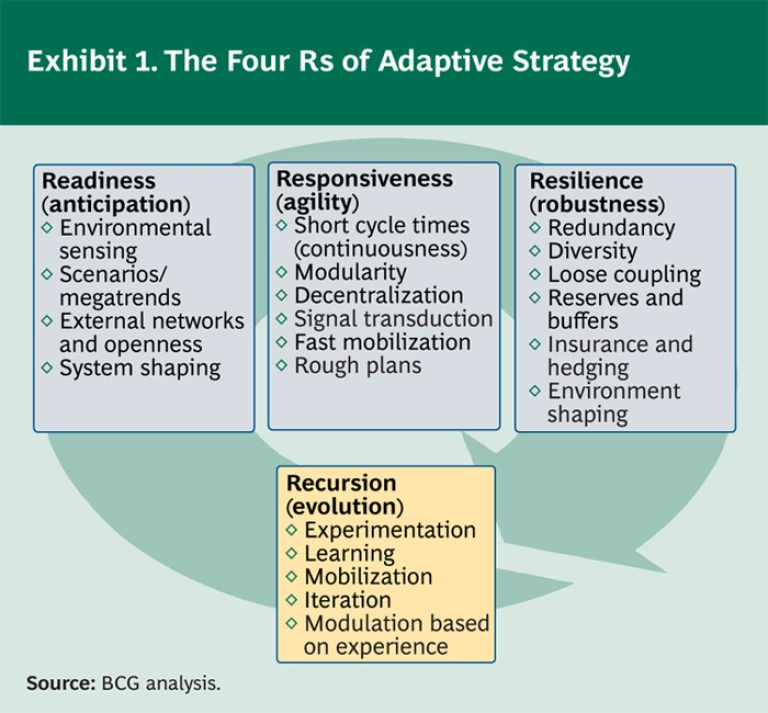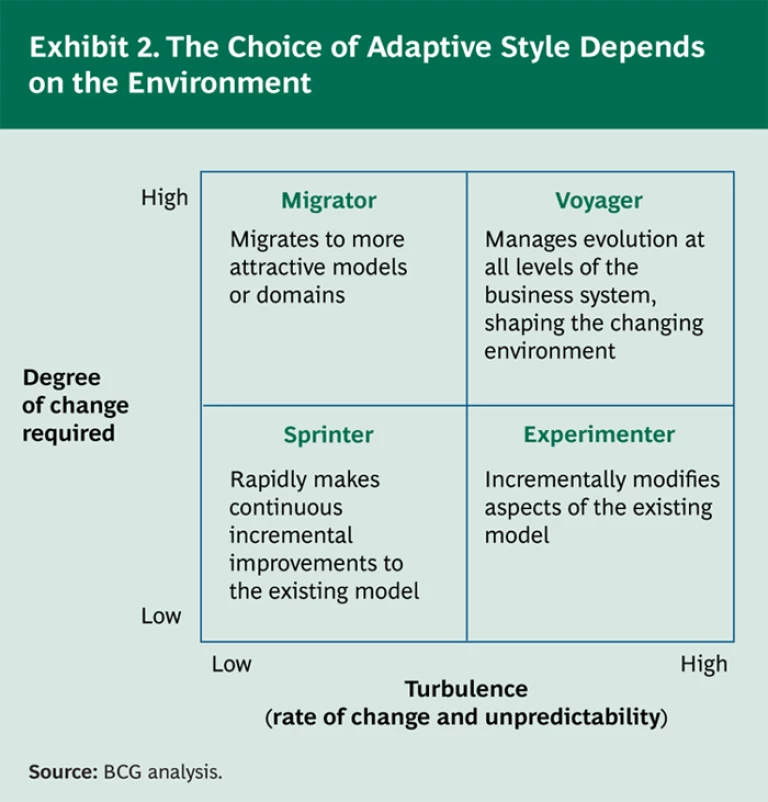In “ New Bases of Competitive Advantage ,” we argued that increased turbulence in the business environment has invalidated an implicit and critical assumption of classical business strategy: that competition is sufficiently stable and predictable for the basis of competitive advantage to be readily determined. Traditional approaches to strategic planning become futile in a world in which the key variables are constantly shifting and difficult to forecast.
We can distinguish three important dimensions of turbulence: volatility in market positions, unpredictability of outcomes, and the widening gap in performance between winners and losers. Most industries have experienced instability on at least one of these dimensions, but some—such as technology-driven industries and commercial banking—have been affected on all three. The hardest-hit industries are those that have been disproportionately affected by globalization, deregulation, digitalization, connectivity, deconstruction, and the shift from products to services. Most companies, and especially those in industries characterized by both unpredictability and a high rate of change, need a more adaptive and dynamic approach to strategy—an approach that emphasizes iterative experimentation in order to overcome the limitations of deductive approaches and keep pace with incessant change.
With such an approach, organizations gain adaptive advantage: the ability to achieve superior outcomes in a turbulent environment by continuously reshaping the enterprise through a process of managed evolution. In this article, we explain how adaptive advantage can be harnessed in practice.
Elements of Adaptive Advantage
Three attributes are essential for survival in a changing environment: readiness, responsiveness, and resilience. They can be achieved by static measures such as improved forecasting, decentralized decision-making, and buffering with excess capacity, respectively. However, to gain a sustainable advantage in a turbulent environment, companies must employ a more dynamic, recursive approach in which better-fitting strategies continuously evolve in response to change. (See Exhibit 1.)
Recursion occurs through a four-component iterative process comprising variation, selection, and amplification, with modulation at its center (VSAM).
Variation. Novelty is essential in responding to a changing environment. Methods of achieving variation include targeted innovation and natural or induced modification of internal practices. Responding to signals from the external environment or leveraging the innovative capacities of external stakeholders can also be used to generate variation.
Selection. Variation alone will not allow companies to adapt to a changing environment. The most promising variations must be selected through such mechanisms as stage gates and portfolio management, pilot projects or limited tests, and full-scale tests conducted directly in the marketplace.
Amplification. Selected variations must be scaled up, optimized, and, where appropriate, hard-wired into the routines and structures of the organization, either through a formal and deliberate process of resource allocation or indirectly, through internal or external competition.
Modulation. Modulation is the locus of strategic intent. It shapes and fine-tunes the other three components of the adaptive system in response to the environmental context and corporate goals and capabilities. Adaptive strategy is thus quite different from biological evolution, in which no overarching will or intention is at work.
Although each component in the VSAM loop may seem familiar, the adaptive approach is unlike classical strategy in a number of fundamental respects. First, it works by modulating the context from which new strategies emerge, rather than specifying exactly what those new strategies should be. Second, it largely erases the distinction between planning and implementation, since successful strategies emerge from practice rather than from analysis and design. The discipline of adaptive strategy therefore centers on the choices a company makes in the VSAM loop in order to fit the adaptive mechanism to the environmental context.
Styles of Adaptive Strategy
As noted above, there are many ways of executing and modulating the activities of the VSAM loop. The choices relate principally to four factors:
- Degree of Proactivity. Do the adaptive mechanisms anticipate and shape change, or do they simply react effectively to it?
- Degree of Modification. Is adaptation directed merely at the level of products and processes or, more fundamentally, at the level of the business model or the extended business system?
- Degree of Exploration. Is the focus on refining and exploiting a successful model, or on exploring new frontiers and possibilities?
- Degree of Intentionality. Are the adaptive mechanisms primarily analytical, structured, programmed, and deliberate, or do they emerge indirectly as a result of either internal or external collaboration or competition?
A company’s optimal choices are mainly a function of the environment—especially the rate at which it is changing, the predictability of change, and the degree of change required. There are four broad styles of adaptive strategy. (See Exhibit 2.)
The Sprinter. In environments with only a moderate degree of both turbulence and required change, companies can focus on rapidly optimizing and exploiting existing business models to track an increasingly volatile environment. The fashion retailer Zara, for example, focuses on building a fast feedback cycle between sales data from its stores and the design and manufacture of new products. This model allows the company to stay at the forefront of fashion trends without having to make big bets on where the trends are headed.
The Experimenter. In environments where turbulence is high but the degree of change required is low, companies whose business models are fundamentally sound must nevertheless modify their product mix or other low-level aspects of their business through a process of iterative experimentation. McDonald’s, for example, uses a structured process to design, test, and introduce menu items while keeping its overarching business model unchanged. This enables it to evolve along with customer preferences and still preserve the well-honed efficiency of the kitchen model at the core of its operations.
The Migrator. In environments with moderate turbulence and a high degree of required change, companies must deliberately migrate their obsolescent business models or domains toward more attractive ones using a targeted and deliberate process. Virgin, for instance, systematically manages a diverse portfolio of challenger businesses by rapidly scaling up potential winners and cleanly divesting or shutting down losers.
The Voyager. In environments with a high degree of both turbulence and required change, companies need to deploy an exploratory approach to the business model or system. This can involve “live” tests with a mixed portfolio of competing business models and strategies, some of which may even be mutually contradictory.
Netflix, which has reinvented fundamental aspects of its business strategy and model several times in the extremely turbulent movie-rental business, is a good example of a voyager. It removed late fees (at one time a mainstay of industry profits) and is exploring video streaming on a variety of platforms, potentially cannibalizing its DVD-by-mail business in order to stay ahead of the competition. Netflix has succeeded in dominating and reshaping a chaotic industry in which less adaptive competitors have fared poorly.
Beginning the Journey
Adaptive advantage is a powerful concept for companies facing unstable environments. It involves not only different ways of operating but also very different ways of thinking about strategy. The first step in embracing adaptive advantage is therefore to create awareness of the challenges and opportunities presented by turbulence and unpredictability—and the adaptive choices available.
Leaders can begin the journey by asking their management teams to consider five basic questions:
How rapidly and fundamentally is the basis of advantage changing in our industry?
How effectively are we tracking, shaping, and adapting to these changes?
What is the cost of not adapting to change?
Which of the four styles of adaptive strategy—sprinter, experimenter, migrator, or voyager—would be most appropriate, given our environment and situation?
What practices, capabilities, or beliefs are bottle-necking our ability to embrace and deploy adaptive advantage?
We believe that adaptive advantage will increasingly supplement the traditional advantages of position and capability. Adaptive advantage is supported and complemented by five additional sources of advantage: signal advantage, systems advantage, social advantage, simulation advantage, and people advantage, which we will explore in forthcoming articles in this series.











